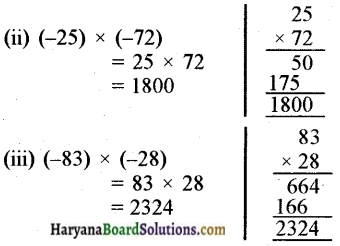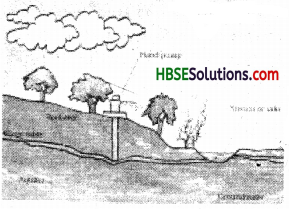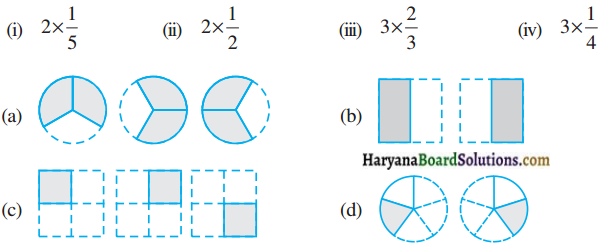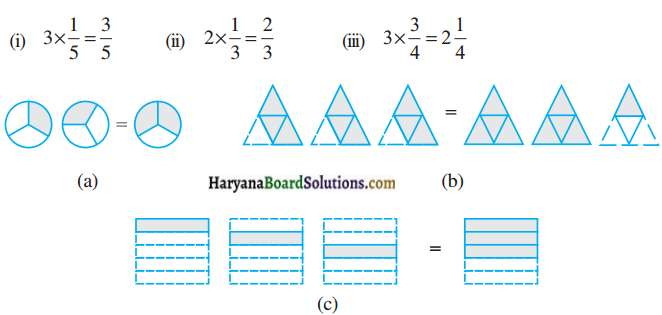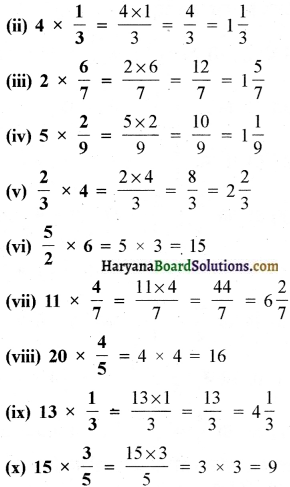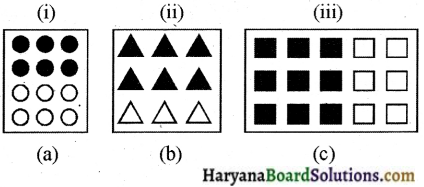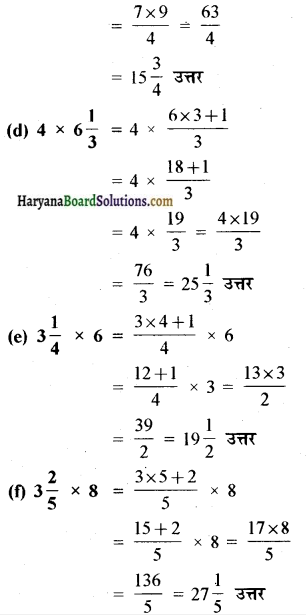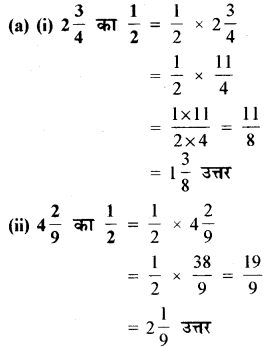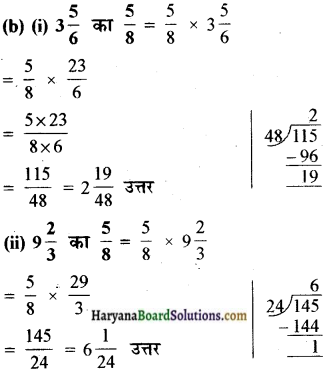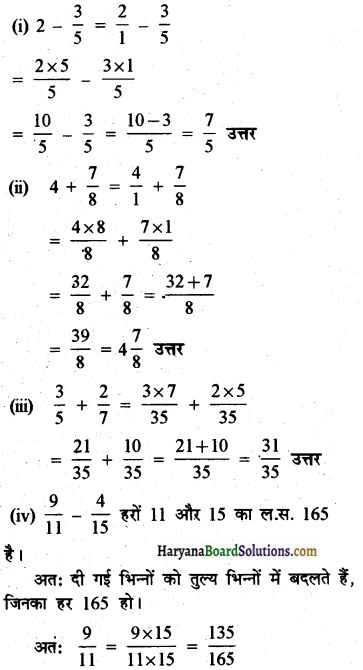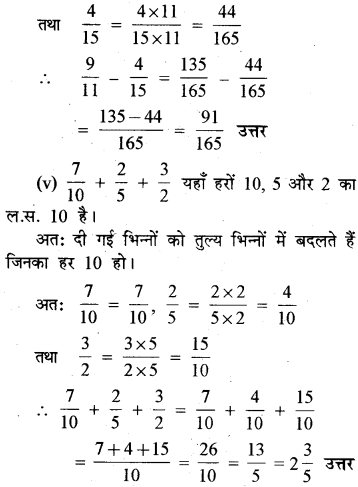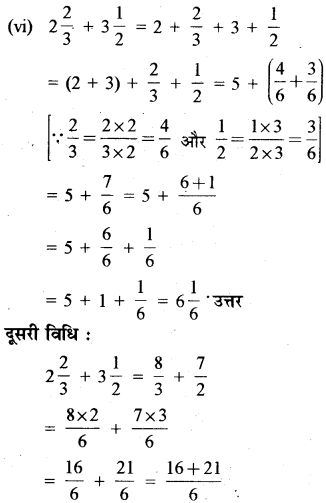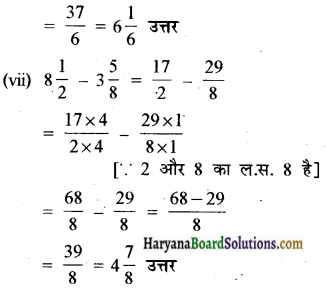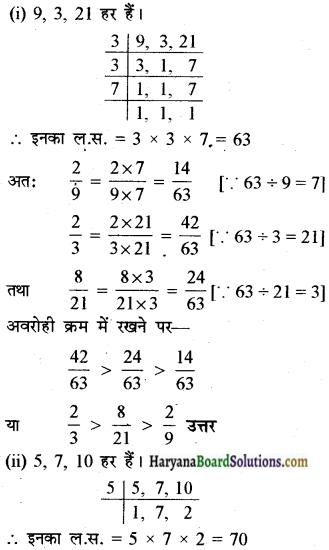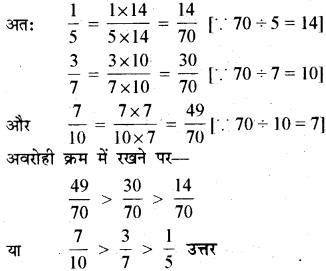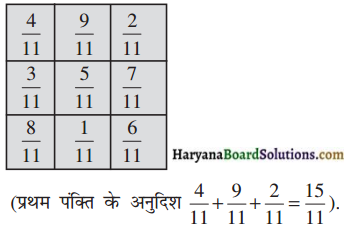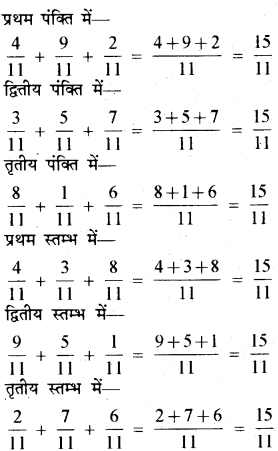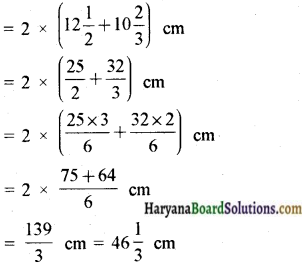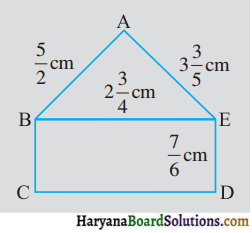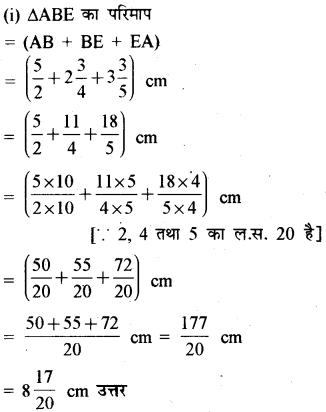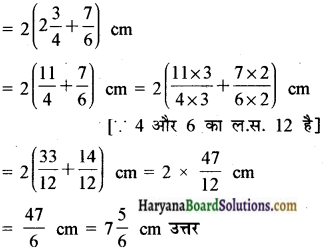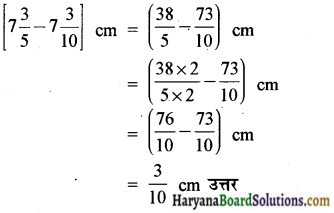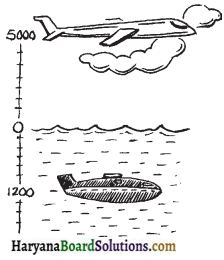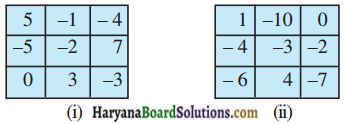HBSE 7th Class Maths Solutions Chapter 1 पूर्णांक Ex 1.3
Haryana State Board HBSE 7th Class Maths Solutions Chapter 1 पूर्णांक Ex 1.3 Textbook Exercise Questions and Answers.
Haryana Board 7th Class Maths Solutions Chapter 1 पूर्णांक Ex 1.3
प्रश्न 1.
निम्नलिखित गुणनफलों को ज्ञात कीजिए:
(a) 3 × (-1)
(b) (-1) × 225
(c) (-21) × (-30)
(d) (-316) × (-1)
(e) (-15) × 0 × (-18)
(f) (-12) × (-11) × (10)
(g) 9 × (-3) × (-6)
(h) (-18) × (-5) × (-4)
(i) (-1) × (-2) × (-3) × 4
(j) (-3) × (-6) × (-2) × (-1)
हल :
(a) 3 × (-1) = – 3
(b) (-1) × 225 = – 225
(c) (-21) × (-30) = 630
(d) (-316) × (-1)= 316
(e) (-15) × o × (-18)
= [(-15) × 0] = (-18)
= 0 × (-18) = 0
(f) (-12) × (-11) × (10)
= [(-12) × (-11)] × 10
= (132) × (10) = 1320
(g) 9 × (-3) × (-6)
= [9 × (-3)] × (-6)
= (-27) × (-6) = 162
(h) (-18) × (-5) × (-4)
= [(-18) × (-5)] × (-4)
= 90 × (-4) = – 360
(i) (-1) × (-2) × (-3) × 4
= [(-1) × (-2)] × [(-3) × 4]
= (2) × (-12) = – 24
(j) (-3) × (-6) × (-2) × (-1)
= [(-3) × (-6)] × [(-2) × (-1)]
= (18) × (2) = 36
![]()
प्रश्न 2.
निम्नलिखित को सत्यापित कीजिए:
(a) 18 × [7 + (-3)] = [18 × 7] + [18 × (-3)]
(b) (-21) × [(-4) + (-6)] = [(-21) × (-4) + [(-21) x (-6)]
हल :
(a) 18 × [7 + (-3)]
= 18 × 4 = 72
तथा [18 × 7] + [18 × (-3)]
= 126 – 54 = 72
∴ 18 × 17+ (-3)] = [18 × 7] + [18 × (-3)]
(b) (-21) × [(-4) + (-6)]
= (-21) × (-4 – 6)
= (-21) × (-10) = 210
तथा [(-21) × (-4)] + [(-21) × (-6)]
= 84 + 126 = 210
∴ (-21) [(-4) + (-6)] = [(-21) × (4)] + [(-21) × (-6)]
प्रश्न 3.
(i) किसी भी पूर्णाक के लिए,(-1) × a किसके समान है?
(ii) वह पूर्णांक ज्ञात कीजिए, जिसका (-1) के साथ गुणनफल है:
(a) -22
(b) 37
(c) 0
हल :
(i) किसी भी पूर्णांक के लिए (-1) × a = – a
(ii) हम जानते हैं कि किसी भी संख्या और (-1) का गुणा उस संख्या का योज्य प्रतिलोम होता है।
अतः (a) -22 का योज्य प्रतिलोम 22 है।
(b) 37 का योज्य प्रतिलोम – 37 है।
(c) 0 का योज्य प्रतिलोम 0 है।
![]()
प्रश्न 4.
(-1) × 5 से आरम्भ करके विभिन्न गुणनफलों द्वारा कोई पैटर्न दर्शाते हुए (-1) × (-1) = 1 को निरूपित कीजिए।
हल :
(-1) × 5 = -5
(-1) × 4 = – 4 = – 5 + 1
(-1) × 3 = – 3 = – 4 + 1
(-1) × 2 = – 2 = – 3 + 1
(-1) × 1 = – 1 = – 2 + 1
(-1) × 0 = – 1 + 1 = 0
(-1) × (-1)= 0 + 1 = 1
प्रश्न 5.
उचित गुणों का उपयोग करते हुए, गुणनफल ज्ञात कीजिए:
(a) 26 × (-48) + (-48) × (-36)
(b) 8 × 53 × (-125)
(c) 15 × (-25) × (4) × (-10)
(d) (-41) × 102
(e) 625 × (-35) + (-625) × 65
(f) 7 × (50 – 2)
(g) (-17) × (-29)
(h) (-57) × (-19) + 57
हल :
(a) 26 × (-48) + (-48) × (-36)
= (-48) × 26 + (-48) × (-36)
= (-48) × [26 + (-36)]
= (-48) × (26 – 36)
= (-48) × (-10) = 480
(b) 8 × 53 × (-125)
= [8 × (-125)] × 53
= (-1000) × 53
= – 53000
(c) 15 × (-25) × (4) × (-10)
= 15 × [(-25) × (-4)] × (- 10)
= 15 × (100) × (-10)
= (15 × 100) × (-10)
= 1500 × (-10) = – 15000
(d) (-41) × 102
= (-41) × (100 + 2)
= (41) × 100 + (-41) × 2
= – 4100 – 82 = – 4182
(e) 625 × (-35) + (-625) × 65
= 625 × (-35) + (625) × (-65)
= 625 × [(-35) + (-65)]
= 625 × (-100) = – 62500
(f) 7 × (50 – 2)
= 7 × 50 – 7 × 2
= 350 – 14 = 336
(g) (-17) × (-29)
= (-17) × [(-30) + 1]
= (-17) × (-30) + (-17) × 1
= 510 – 17 = 493
(h) (-57) × (-19) + 57
= 57 × 19+ 57 × 1
= 57 × (19 + 1)
= 57 × 20
= 1140
![]()
प्रश्न 6.
किसी हिमीकरण (ठण्डा) प्रक्रिया में, कमरे के तापमान को 40°C से 5°C प्रति घण्टे की दर से कम करने की आवश्यकता है। इस प्रक्रिया के शुरू होने के 10 घण्टे बाद, कमरे का तापमान क्या होगा?
हल :
कमरे का आरम्भिक तापमान = 40°C
प्रति घण्टा तापमान कम होगा = – 5°C
10 घण्टे बाद तापमान कम हुआ
= (-5) × 10°C = – 50°C
∴ 10 घण्टे बाद कमरे का तापमान
= 40°C – 50°C – 10°C
प्रश्न 7.
दस प्रश्नों वाले एक कक्षा टेस्ट में प्रत्येक सही उत्तर के लिए 5 अंक दिए जाते हैं और प्रत्येक गलत उत्तर के लिए (-2) अंक दिए जाते हैं एवं प्रयल नहीं किए गए प्रश्नों के लिए शून्य दिया जाता है।
(i) मोहन चार प्रश्नों का सही और छ: प्रश्नों का गलत उत्तर देता है। उसके द्वारा प्राप्त अंक कितने हैं?
(ii) रेशमा के पाँच उत्तर सही हैं और पाँच उत्तर गलत हैं। उसके द्वारा प्राप्त अंक कितने हैं?
(iii) हीना ने कुल सात प्रश्न किए हैं उनमें से दो का उत्तर सही है और पाँच के उत्तर गलत हैं। तो उसे कितने अंक प्राप्त होते हैं?
हल :
(i) प्रत्येक सही उत्तर के लिए दिए गए अंक = 5
अत: चार सही उत्तरों के लिए दिए गए कुल अंक = 5 × 4 = 20
एक गलत उत्तर के लिए दिया गया अंक = (-2)
अतः छः गलत उत्तरों के लिए दिए गए अंक
= (-2) × 6 = – 12
अतः मोहन द्वारा प्राप्त अंक = 20 – 12 = 8 अंक
(ii) रेशमा द्वारा 5 सही उत्तरों के लिए प्राप्तांक = 5 × 5 = 25
रेशमा द्वारा 5 गलत उत्तरों के लिए प्राप्तांक = (-2) × 5 = – 10
अतः रेशमा द्वारा प्राप्त अंक = 25 – 10 = 15 अंक
(iii) हीना के 2 सही उत्तरों के लिए प्राप्तांक
5 × 2 = 10
हीना द्वारा 5 गलत उत्तरों के लिए प्राप्तांक
– 2 x 5 = – 10
अत: हीना द्वारा प्राप्त अंक
10 + (-10) = 10 – 10 = 0
प्रश्न 8.
एक सीमेन्ट कम्पनी को सफेद सीमेन्ट बेचने पर 8 रुपये प्रति बोरी की दर से लाभ होता है और स्लेटी (Grey) रंग की सीमेन्ट बेचने पर 5 रुपये प्रति बोरी की दर से हानि होती है।
(a) किसी महीने में वह कम्पनी 3000 बोरियाँ सफेद सीमेन्ट की और 5000 बोरियाँ स्लेटी सीमेन्ट की बेचती है। उसका लाभ अथवा हानि क्या है?
(b) यदि बेची गई स्लेटी सीमेन्ट की बोरियों की संख्या 6400 है, तो कम्पनी को सफेद सीमेन्ट की कितनी बोरियाँ बेचनी चाहिए, ताकि उसे न तो लाभ हो और न ही हानि?
हल :
सफेद सीमेन्ट की एक बोरी पर लाभ = 8 रु.
स्लेटी रंग की सीमेन्ट की एक बोरी पर हानि = – 5 रु.
(a) 3000 बोरियों (सफेद सीमेन्ट) पर लाभ
= (3000 × 8) रु. = 24000 रु.
5000 बोरियों (स्लेटी सीमेन्ट) पर हानि
= (5000 × -5) रु. = – 25000 रु.
अतः हानि = 24000 रु. – 25000 रु. = -1000 रु.
अतः हानि 1000 रु. उत्तर
(b) 6400 स्लेटी सीमेन्ट की बोरियाँ बेचने पर हानि
= (6400 × 5) रु. = 32000 रु.
न लाभ हो और न हानि, इसके लिए उसे सफेद सीमेन्ट पर 32000 रु. लाभ होना चाहिए।
अत: बेची जाने वाली सफेद सीमेन्ट की बोरियों की संख्या = \(\frac{32000}{8}\) = 4000 बोरियाँ उत्तर
![]()
प्रश्न 9.
निम्नलिखित को सत्य कथन में परिवर्तित करने के लिए, रिक्त स्थान को एक पूर्णांक से प्रतिस्थापित कीजिए।
(a) (-3) × …… = 27
(b) 5 × …… = – 35
(c) …… × (-8) = – 56
(d) …… × (-12) = 132
हल :
(a) (-3) × (-9) = 27
(b) 5 × (-7) = – 35
(c) 7 × (-8) = – 56
(d) (-11) × (-12) = 132







